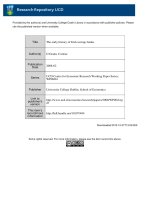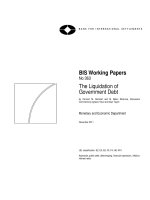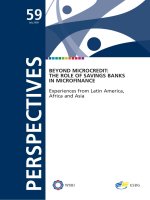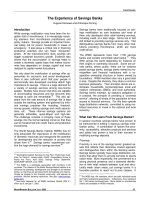The Experience of Savings Banks ppt
Bạn đang xem bản rút gọn của tài liệu. Xem và tải ngay bản đầy đủ của tài liệu tại đây (86.28 KB, 5 trang )
C
ASE
S
TUDIES
M
ICRO
B
ANKING
B
ULLETIN
,
J
ULY
2003
37
The Experience of Savings Banks
Hugues Kamewe and Antonique Koning
Introduction
While savings mobilization may have been the for-
gotten half of microfinance, it is increasingly receiv-
ing attention from microfinance practitioners and
policy makers. Savings provide an important finan-
cial safety net for poorer households in cases of
emergency. It also plays a critical role in financing
productive activities and can foster microenter-
prises. At the macroeconomic level, savings can
trigger sustained economic growth. Evidence also
shows that the accumulation of savings helps to
create a domestic capital base that makes econo-
mies less dependent on foreign capital and more
resistant to capital market fluctuations.
Not only does the mobilization of savings offer op-
portunities for economic and social development,
there is also sufficient proof that poor people in
economically less developed countries attach high
importance to savings. There is a large demand for
a variety of savings services among low-income
people. Studies have proven that they are capable
of accumulating resources and the amounts they
manage to save are remarkable.
64
This also ap-
pears from the vast amount of savings that is kept
outside the banking system and gathered by infor-
mal savings practices like hoarding, livestock,
money guards, rotating savings and credit associa-
tions, etc. These informal savings systems are
generally indivisible, quasi-illiquid and high-risk.
The challenge consists in bringing more of these
savings into the formal banking circuit so that they
can be transformed into credit, loans and productive
investments.
The World Savings Banks Institute (WBSI) has for
long advocated the importance of the mobilization
of domestic resources and recognized the potential
for development and the reduction of poverty that
arises from it.
65
Savings banks’ experiences con-
firm the huge demand for savings services.
66
64
“Developing Deposit Services for the Poor: Preliminary Guid-
ance for Donors”, revised draft, CGAP (Consultative Group to
Assist the Poor), April 2002; Savings Policy Statement,
SUM/UNDP-UNCDF, June 1998.
65
The WSBI is a worldwide association with members in 89
countries. The mission of the World Savings Banks Institute is to
influence the standing, development and strength of all member
banks, so that they are perceived both domestically and interna-
tionally as integral to the financial community, and operate as
proficient, efficient banking institutions. See also: www.savings-
banks.com.
66
Non-bank deposits for all WSBI members totaled US$ 4.1
trillion as of January 1, 2002.
Savings banks have traditionally focused on sav-
ings mobilization as core business and most of
them only developed other retail banking services,
including credit, at a later stage. Some are in fact
still limited to providing savings services only. This
distinguishes savings banks from many other insti-
tutions providing microfinance, which are more
credit driven.
The WSBI represents more than 1,150 savings
banks and socially committed retail banks.
67
They
differ across the world depending for instance on
their origins or ownership structure. Some are pri-
vate banks, others public: there are for instance
postal savings banks, savings banks owned by mu-
nicipalities and financial institutions with a co-
operative ownership structure or banks owned by
foundations. WSBI members also vary a great deal
in size. Despite this diversity, they share a common
business philosophy. Their principal clients are in-
dividuals, households, microenterprises, small and
medium enterprises (SMEs) and local authorities.
Savings banks maintain, by statutory obligation or
in practice, the principle of providing a “universal
service”, allowing all strata of the population to have
access to financial services. For this they operate
large distribution networks, committed to using mo-
bilized resources to invest in the national and local
economy.
What Can We Learn From Savings Banks?
In several countries savings banks have proven to
be instrumental in setting a vigorous savings mobi-
lization policy. A combination of factors like prox-
imity, accessibility, attractive products and services
and safety has proven a key to their success in
mobilizing savings deposits.
Proximity
Proximity is one of the savings banks’ greatest as-
sets that reflects their distinctive market approach
and distinguishes them within the banking sector.
Savings banks typically have large distribution net-
works that allow them to provide services to clients
nation-wide. More importantly, the commitment to a
strong physical presence and a balanced distribu-
tion of their retail network between rural and struc-
turally weak urban areas, put savings banks in a
favorable position to reach out to poor classes. It
67
The WSBI has 104 members, which are both individual banks
and bank federations/associations. Collectively, they represent
the 1,150 banks mentioned here. More details on membership
criteria are available on WSBI’s website.
C
ASE
S
TUDIES
38
M
ICRO
B
ANKING
B
ULLETIN
,
J
ULY
2003
contrasts with the over-concentration in urban and
more prosperous centers of other banks.
On the African continent, postal savings banks are
in many countries the only vehicle for integrating
the formal financial system in remote communities.
In many cases, the retail network of postal savings
banks is by far larger than that of all other banks
together. For instance, the Kenya Post Office Sav-
ings Bank (KPOSB) operates a retail network of
500 outlets compared to approximately 370
branches for all commercial banks. While roughly
80 percent of the latter branches are located in
main cities, only 45 of all outlets operated by the
KPOSB are located within the capital. In Asia,
where financial systems have experienced an im-
pressive development over the past two decades,
savings banks also distinguish themselves with a
strong physical presence. The Government Sav-
ings Bank (GSB) in Thailand manages the second
largest network with 548 branches, just behind the
Bank of Agriculture and Agricultural Cooperatives,
which counts 629 branches. More obvious is the
case of India where mainstream banks manage
67,000 branches altogether, while the postal sav-
ings system operates 154,000 branches nation-
wide, of which 137,000 are in rural areas.
68
In Latin
America, Banco del Estado in Chile for instance is
present in almost a third of all “communes” in the
country, more than any other financial institution.
More than one third of Banco del Estado’s 304
branches are located in remote areas and it oper-
ates 74 mobile branches to further deepen its retail
network.
Figure 1: Branch Network and ATMs of Savings
Banks (as of 01/01/2002)
69
Savings Bank Country Branches ATMs
Banco del Estado Chile 378 768
Banco Caja Social Colombia 122 133
National Bank for
Development
Egypt 66 0
National Savings Or-
ganization (NSO)
India 154,000 0
Kenya Post Office
Savings Bank
Kenya 486 0
Tanzania Postal Bank Tanzania 136 0
Government Savings
Bank
Thailand 585 281
Total World 201,136 132,499
Source: World Savings Banks Institute (WSBI).
68
Geetha Nagarajan, “Going Postal to Deliver Financial Services
to Microclients”, Newsletter, Regional and Sustainable Develop-
ment Department, Asian Development Bank, vol. 4 (1), pp. 5-8,
2003.
Accessibility
Unlike other banks, which might require an exces-
sive minimum amount for opening and holding a
saving account (that in some cases exceeds the per
capita income of the country) and charge relatively
high bank fees for maintaining such an account,
savings banks have low entry barriers for their sav-
ings services. Although conditions for holding a
savings account vary across savings banks, their
practices are invariably more inclusive.
For instance, in Benin and Burkina-Faso, postal
savings banks allow people to open and maintain
passbooks with only CFAF 1,000 (less than US$
1.8). The structure of ordinary savings accounts
shows that the balance does not exceed CFAF
10,000 (US$ 18) for 62 percent of the total number
of accounts in Benin and 36 percent in Burkina-
Faso. In Asian emerging economies, savings
banks have built on technology solutions to show a
remarkable capability in capturing small deposits,
while overcoming underlying operational inefficien-
cies. To open and maintain a savings account re-
quires only RM 1.00 (US$ 0.27) at Bank Simpanan
Nasional in Malaysia.
How savings banks are able to survive holding such
small accounts is a key question. A crucial element
to address this issue is a good diversification of ac-
counts and clients. The benefits derived from larger
accounts are in general used to subsidize costly
small accounts. In addition, larger accounts are
often stable funds collected from contractual sav-
ings schemes. When there are no restrictions, sav-
ings banks can invest these funds in high-earning
investments. Savings banks have adopted price
structures that reflect the cost of transactions for
smaller accounts, charging small fees for regular
transactions above a certain number of operations.
Selling other financial services and products to cli-
ents who save also generates additional income. In
the particular case of postal savings banks, making
use of the postal facilities (staff, infrastructure, func-
tions, etc.) allows them to minimize their costs. In-
vestment in technology has also been instrumental
for controlling costs for the administration of very
small accounts, like for instance in Malaysia and
Thailand.
In addition to low financial barriers, an open and
personalized bank-customer relation contributes to
making savings banks more accessible. The decen-
tralized structure and local roots of savings banks
enable them to adapt to local circumstances and be
“close” to the people.
Attractive Products and Services
Apart from the convenience offered by their network
and low entry barriers, savings banks also respond
C
ASE
S
TUDIES
M
ICRO
B
ANKING
B
ULLETIN
,
J
ULY
2003
39
to the savings patterns of low-income savers
through the type of savings products and services
they offer. Progressively savings banks have de-
signed and commercialized a well-adapted and
segmented range of deposit products to cope with
their clients’ preferences.
These products are a mix of various conditions re-
lated to liquidity, return, minimum requirements and
transaction costs to make them client-friendly and
easy to manage for the institution. On one end,
passbooks combine low minimum balance and low
return with full liquidity, while on the other end, pen-
sion schemes allow long-term accumulation of capi-
tal and mix illiquidity with high return. In between,
other products can be found in savings banks, such
as "Save as you earn", like the SAYE product of the
KPOSB, "Savings certificates" and "Fixed deposits".
Many savings banks have developed special prod-
ucts for targeting niche markets like youth and insti-
tutions (NGOs, women groups, schools). Examples
of this can be found in Senegal where the "rural
savings account" was created for grassroots or-
ganizations and women’s groups. The National
Savings Bank of Sri Lanka introduced special sav-
ings accounts for children called Punchi Hapan (0
to 7 years), Hapan (7 to 16 years) and for young-
sters up to 30, Ithuru Mithuru; all designed with
special features and promotional campaigns to tar-
get these groups. Savings related to future invest-
ments in housing or education have also had a lot
of success in savings banks around the world.
Sometimes incentives are used in the commerciali-
zation of savings products to reward additional in-
creases in deposits, such as a bonus for reaching
certain limits within a period of time. In the Peru-
vian savings banks for example this premium can
be given in the form of a lottery ticket, with which
the saver can win small domestic appliances.
Sometimes incentives are used in the commerciali-
zation of savings products and services to reward
additional increases in deposits. The savings
banks’ experience also shows that providing addi-
tional financial services to peoples’ savings, such
as life insurance, transfer and payment services,
encourages people to save.
Safety of Deposits
One of the principal concerns of savers is the safety
of their deposits. This has partly to do with having
an appropriate secure physical infrastructure, which
savings banks in general do. But just as important
is the formal character of savings banks, which con-
trasts to some of the informal savings systems
mentioned earlier. In some cases also the explicit
or implicit relation with the government provides a
sense of security. The state guarantee of deposits
protects people’s savings. In addition, most sav-
ings banks are, like any other financial intermediary,
subject to regulations enforcing financial discipline
and are properly supervised. The postal savings
banks are maybe an exception to this rule, as in
most countries they fall under the Ministry that is in
charge of postal services.
Current and Future Challenges of Savings
Banks Around the World
Good Corporate Governance
Although the governance of an institution is often
linked with its ownership structure, the latter is not
the prime-determining factor in whether or not a
bank is successful. Experience from savings banks
teaches us that good corporate governance is much
more instrumental. Institutional integrity and profi-
ciency, crucial elements of good corporate govern-
ance, are key to a well functioning bank.
Institutional integrity implies that banks ideally have
an independent legal and management structure.
This is not the case everywhere and often political
interference is a matter of concern. Since savings
mobilization is largely based on confidence, trans-
parency about the operations of the bank is also
essential. It goes without saying that, for an institu-
tion to be efficient, a sound financial management is
fundamental. Internal and external control mecha-
nisms need to be effective. This is why regulation
and supervision of savings banks are so important.
Preferably all financial intermediaries should be
properly regulated and supervised by the relevant
authorities.
Sustainability
Another major challenge for savings banks, as for
all financial intermediaries reaching out to the poor-
est, is sustainability. To serve a large number of
customers, process high volumes of low value
transactions and maintain a large physical presence
results in high operational costs. At the same time
fair returns are expected by savers.
Achieving financial sustainability depends on the
capacity of savings banks to achieve high levels of
efficiency. The challenge is to maintain operational
costs under control while raising the income base
without compromising the social mandate of the
bank. On the cost side, this implies the implemen-
tation of appropriate measures to control costs and
streamline internal processes. It also involves good
pricing of savings products, which requires thor-
ough market research. Investments in technologies
should be weighed against the savings that can be
made and additional benefits to clients.
On the revenue side, a diversification of products
and services can contribute to achieving financial
C
ASE
S
TUDIES
40
M
ICRO
B
ANKING
B
ULLETIN
,
J
ULY
2003
sustainability. Experiences from savings banks in
introducing more sophisticated savings schemes
have shown some positive results. Contractual
savings schemes, which provide more stable funds,
can help to generate significant revenues from in-
vestments. In addition, they can attract large ac-
counts, which appropriately charged can cross-
subsidize small accounts.
Most savings banks create revenue from other ser-
vices, including money transfer and marketing in-
surance policies. Capitalizing on this experience,
savings banks can be instrumental in offering a va-
riety of services to microfinance institutions (MFIs).
They can be cost-effective solutions for securing
and transferring MFIs funds, as well as offering
payment facilities in areas where other banks do
not reach.
Optimal Investment of Mobilized Resources
A large number of savings banks are offering retail
lending services, including housing finance, as part
of their core business. They have built consider-
able experience in these areas over the years and
are successful. Banco Caja Social in Colombia and
the Municipal Savings Banks in Peru are examples
of institutions with a strong reputation in microfi-
Figure 2: Savings Mobilization by a Selection of Savings Banks (as of 01/01/2002)
Savings
Bank
Country
Savings
Accounts
(1)
(number)
Non-Bank
Deposits
(2)
(US$ million)
Return on
Assets
(%)
Operating
Income/
Average
Assets (%)
Operating
Cost/
Average
Assets (%)
Savings
Accounts/
Staff
(%)
Banco del Estado Chile 11,052,000 2,726.00 0.64 4.86 3.59 1,503
Banco Caja Social Colombia 1,100,000 432.11 2.96 18.85 14.29 430
National Bank for
Development
Egypt n.a. 1,268.70 0.91 2.23 1.31 n.a.
Kenya Post Office
Savings Bank
Kenya 1,650,000 100.33 0.56 17.88 17.31 1,243
Tanzania Postal
Bank
Tanzania 1,000,000 45.21 2.17 13.90 11.74 2,421
Government
Savings Bank
Thailand 27,450,000 11,048.45 1.98 3.21 1.16 2,877
Source: World Savings Banks Institute (WSBI). For a full list of members, go to www. savings-banks.com.
(1)
Approximate;
(2)
All deposits received except for deposits that are placed by other banks – includes both mandatory and voluntary sav-
ings, although mandatory savings are minimal.
nance. Apart from the investment of mobilized re-
sources in local and regional economic activities,
these institutions contribute a part of their profit to
community development projects.
Wherever savings banks have close ties with na-
tional governments, their role in economic devel-
opment is often downplayed. In Africa and Asia
several of these savings banks are restricted in
their investment policy and have either to entrust
their deposits with the national Treasuries or to
support fiscal policies by investing in government
securities. Savings banks that have been granted
some autonomy are generally still constrained to
invest their surplus preferably in public sector secu-
rities.
The removal of legislative constraints has allowed
an increasing number of savings banks to move
with caution into lending. A successful case has
been that of the Government Savings Bank (GSB)
in Thailand. Twenty years ago, government securi-
ties represented 94 percent of the bank’s invest-
ment portfolio. Today, GSB offers a range of recip-
rocal savings-credit facilities (i.e., personal loan,
educational loan, corporate loan, social loan, hous-
ing loan) and government securities have fallen be-
low 50 percent of the bank’ investment portfolio.
Likewise, some former post office savings banks
have been scaled-up and successfully converted
into national (postal) savings banks (i.e., Malaysia,
Sri Lanka and Tanzania) allowed to diversify in
other business. For instance, Bank Simpanan Na-
sional in Malaysia has diversified in public and pri-
vate companies securities/loans, stocks and
shares, and government securities represent only
30 percent of the bank investment portfolio. Other
savings banks have been transformed into fully-
fledged retail banks allowed to provide credit ser-
vices (i.e., Cape Verde and Mali).
Although a large number of savings banks are not
yet suitable for retail lending – and should not be
advised to undertake this business unless they
achieve necessary reforms – this does not preclude
them and policy makers from thinking about possi-
ble alternatives to the government for investing their
resources. Furthermore, savings banks may find
ethical and lucrative opportunities in the microfi-
nance sector. This industry remains heavily subsi-
dized in Asia, where most often MFIs rely on gov-
ernment and central banks discount credit lines,
C
ASE
S
TUDIES
M
ICRO
B
ANKING
B
ULLETIN
,
J
ULY
2003
41
and in Africa with the importance of donor funding
of their operations. The ongoing institution building
process in the microfinance industry may offer a
real opportunity for savings banks to channel part of
their resources to sound and promising MFIs for on-
lending to their clients.
Another approach to encourage an optimal invest-
ment of savings banks’ deposits can be to team
them up with public or private rural finance institu-
tions. The traditional view may also suggest to de-
velop housing finance operations where savings
banks in Western Europe and US have shown an
impressive concentration of their business.
Conclusion
The role of savings banks is undisputable for the
large and cost-effective distribution of basic savings
services in developing and emerging economies.
As solid financial intermediaries operating in the
formal sector they merit the public confidence that
allows them to mobilize resources massively. The
trend for savings banks is to become more instru-
mental in supporting capital base formation at na-
tional level. The efficacy of savings banks in reduc-
ing financial exclusion in their economies can be
further improved by the removal of specific legal
and institutional constraints on their operations and
by addressing governance issues. Finally, savings
banks will have to cope with the challenges associ-
ated with globalization while preserving their distinc-
tive identity as local institutions committed to the
society they operate in.
Hugues Kamewe and Antonique Koning are Advisers at
the World Savings Banks Institute. They can be reached
at and









